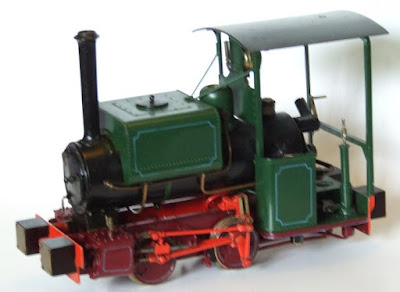We look forward to seeing friends old and new at the Garden
Railway Show in Peterborough
on April 6th.
Thanks to our new white-metal caster - Sarum Castings - we should have some
signal kits in stock. Every enthusiast’s line should have a few of these
semaphore signals, lending character and authenticity. Such signals have always
had line-side appeal but they are genuinely important aspects of railway
working.
 |
| Every branch-line needs one! Wrightscale 16mm Mckenzie and Holland home signal |
As railways spread, ‘line of sight working’ became obsolete
and dangerous. Yes! we all know and love that scene in ‘The Railway Children’
where Jenny Agutter and the others wave red flannel petticoats to stop a train,
but, alas, Jenny Agutter isn’t always available! To warn and control traffic, semaphore
signals were introduced in the early 1840s. The message each signal sent could
be seen both by day and night; the message sent by the signal arm was automatically
reinforced by its companion, the signal light. Highly visual and practical,
they were soon adopted everywhere. Mckenzie and Holland introduced the version shown in the 1880s. Many lingered on branch-lines for years.
Each semaphore signal arm consists of a blade, usually
painted red on the business side to render it more conspicuous and striped to provide contrast. The
second vital component is a 'spectacle' holding coloured lenses. A quick look at the drawing below shows why it was called a spectacle! For a simple
Home signal, the spectacle colours would be red and green. In early days, when
the lamp was lit by oil, emitting a warm yellow hue, the lens in the spectacle
would be blue; if a green lens was used, the overall effect would be too
yellow, therefore confusing. Depending on the position of the arm, the
appropriate coloured lens covers the lamp indicating red for stop, yellow for
caution, green for clear.
 |
| Signal blade and two-colour spectacle on Wrightscale 16mm signal kit |
On modern railways,
the semaphore signal has largely been replaced by electric or by radio
signalling in the driver’s cab. Thus the picturesque semaphore is rarely seen
these days..
In my experience of railways in the Sixties, control was never provided elecrically. Passing tokens were used on the Deeside Line which ran up to Ballater, Aberdeenshire. Apart from the short trip between Aberdeen Joint Station and
Ferryhill, the railway was a simple branch-line with passing loops. Passengers would try
and sit on the side of ‘The Sputnik’ with a view of the station. If we were
lucky, we’d draw up alongside the Sputnik’s waiting twin (actually a diesel-driven Craven two-car unit) and see the token passing
from one to the other. Ah! Happy days, ruined by Dr Beeching! The line closed
in early 1966. The Sputnik, a.k.a. battery railcar, still exists at Crathes, on
a short length of the original Deeside Line which has been reopened as a
tourist railway.
For Malcolm, the fondest memory is of semaphore signals,
such as the one used on the Festiniog Railway. Almost the first
model he made was a Home Signal. He chose a Mckenzie and Holland prototype –
many were found in the LNER region, strong in his home town, and also the
‘classic’ signal on the Festiniog Line. These Mckenzie and Holland are ‘lower
quadrant’ signals – the business is done between the nine o’clock and six
o’clock positions. Bernard Wright and J.H. Wright (no relation) produced a
series of articles in Model Railways magazine 1988, which were helpful.
 |
| Lamp and ladder on 16mm Wrightscale signal kit |
16mm is an unforgiving scale. Metal should be represented by
metal, wood by wood and so on, so all the kits require components in white
metal, wood, wire, gel in at least two colours and so on. The signals can be
electrified so even more components can be needed. The lenses (supplied) are
made of red or green gel; a modern LED or grain-of-wheat bulb doesn’t have the
yellowish hue of the original oil lamp.
 |
| The shoe at the base and the lower end of the connecting rod; Wrightscale 16mm signal kit |
As well as signal blade and spectacle, the vital components
are post, ladder and rail, lamp, balance and bearing plate. On railways such as
the old Southern, signal posts could be improvised from old lengths of rail.
Mckenzie and Holland
preferred wood. This was crowned with a finial, not just for aesthetic reasons
but also to protect the top of the post from the elements. The post was slipped into
a metal shoe to help protect the wood from the damp ground. The balance and bearing
plate ensure a smooth arc of movement. The ladder and crow’s nest made it
possible for the lamp to be serviced. Brackets reinforced load-bearing parts.
The rod made it possible to control the signal…. You knew all this anyway!
 |
| The view of the signal as it recedes into the distance. Made from a 16mm Wrightscale kit |
Malcolm did produce a bracket signal and offer a number of
options – long and short finials, spectacles ancient and modern and so on.
Unfortunately, as any supplier knows, the customer will always ask for a short
finial when there is only a long finial in stock or new-style spectacles when the only ones available are old-style. We’ll have to let you know
what our caster can come up with in time for the Show.








